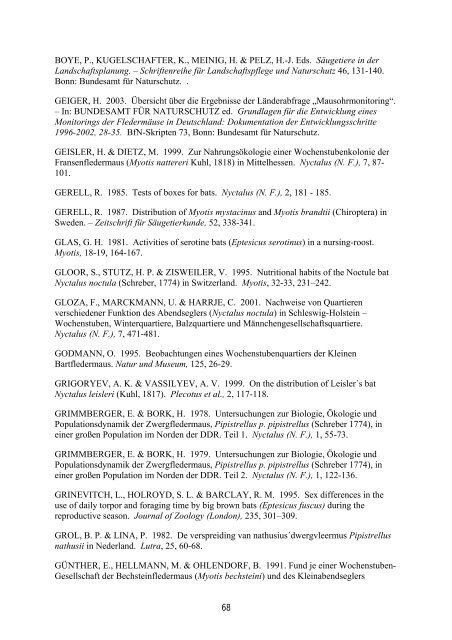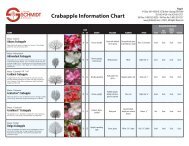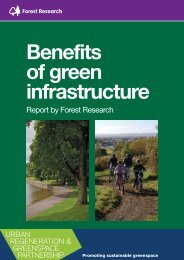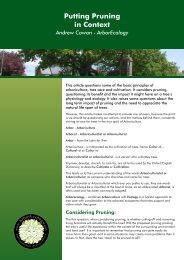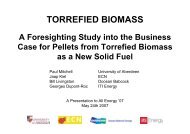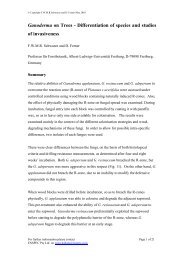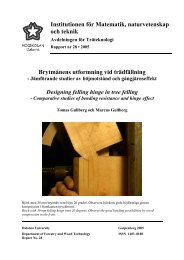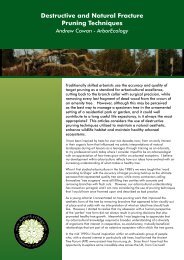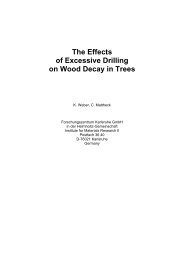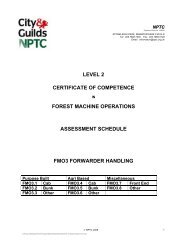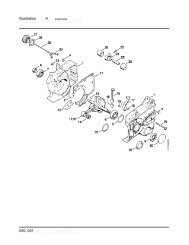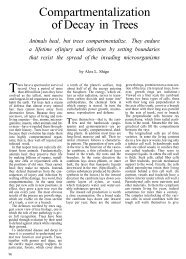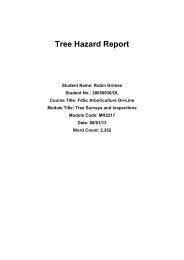BOYE, P., KUGELSCHAFTER, K., MEINIG, H. & PELZ, H.-J. Eds. Säugetiere in derLandschaftsplanung. – Schriftenreihe für Landschaftspflege und Naturschutz 46, 131-140.Bonn: Bundesamt für Naturschutz. .GEIGER, H. 2003. Übersicht über die Ergebnisse der Länderabfrage „Mausohrmonitoring“.– In: BUNDESAMT FÜR NATURSCHUTZ ed. Grundlagen für die Entwicklung einesMonitorings der Fledermäuse in Deutschland: Dokumentation der Entwicklungsschritte1996-2002, 28-35. BfN-Skripten 73, Bonn: Bundesamt für Naturschutz.GEISLER, H. & DIETZ, M. 1999. Zur Nahrungsökologie einer Wochenstubenkolonie derFransenfledermaus (Myotis nattereri Kuhl, 1818) in Mittelhessen. Nyctalus (N. F.), 7, 87-101.GERELL, R. 1985. Tests of boxes <strong>for</strong> bats. Nyctalus (N. F.), 2, 181 - 185.GERELL, R. 1987. Distribution of Myotis mystacinus and Myotis brandtii (Chiroptera) inSweden. – Zeitschrift für Säugetierkunde, 52, 338-341.GLAS, G. H. 1981. Activities of serotine bats (Eptesicus serotinus) in a nursing-roost.Myotis, 18-19, 164-167.GLOOR, S., STUTZ, H. P. & ZISWEILER, V. 1995. Nutritional habits of the Noctule batNyctalus noctula (Schreber, 1774) in Switzerland. Myotis, 32-33, 231–242.GLOZA, F., MARCKMANN, U. & HARRJE, C. 2001. Nachweise von Quartierenverschiedener Funktion des Abendseglers (Nyctalus noctula) in Schleswig-Holstein –Wochenstuben, Winterquartiere, Balzquartiere und Männchengesellschaftsquartiere.Nyctalus (N. F.), 7, 471-481.GODMANN, O. 1995. Beobachtungen eines Wochenstubenquartiers der KleinenBartfledermaus. Natur und Museum, 125, 26-29.GRIGORYEV, A. K. & VASSILYEV, A. V. 1999. On the distribution of Leisler´s batNyctalus leisleri (Kuhl, 1817). Plecotus et al., 2, 117-118.GRIMMBERGER, E. & BORK, H. 1978. Untersuchungen zur Biologie, Ökologie undPopulationsdynamik der Zwergfledermaus, Pipistrellus p. pipistrellus (Schreber 1774), ineiner großen Population im Norden der DDR. Teil 1. Nyctalus (N. F.), 1, 55-73.GRIMMBERGER, E. & BORK, H. 1979. Untersuchungen zur Biologie, Ökologie undPopulationsdynamik der Zwergfledermaus, Pipistrellus p. pipistrellus (Schreber 1774), ineiner großen Population im Norden der DDR. Teil 2. Nyctalus (N. F.), 1, 122-136.GRINEVITCH, L., HOLROYD, S. L. & BARCLAY, R. M. 1995. Sex differences in theuse of daily torpor and <strong>for</strong>aging time by big brown bats (Eptesicus fuscus) during thereproductive season. Journal of Zoology (London), 235, 301–309.GROL, B. P. & LINA, P. 1982. De verspreiding van nathusius´dwergvleermus Pipistrellusnathusii in Nederland. Lutra, 25, 60-68.GÜNTHER, E., HELLMANN, M. & OHLENDORF, B. 1991. Fund je einer Wochenstuben-Gesellschaft der Bechsteinfledermaus (Myotis bechsteini) und des Kleinabendseglers68
(Nyctalus leisleri) sowie zur Besiedlung von Spechthöhlen in naturnahen Laubwäldern desnördlichen Harzes durch Fledermäuse. Nyctalus (N. F.), 4, 7-16.GÜTTINGER, R. 1997. Jagdhabitate des Grossen Mausohrs (Myotis myotis) in dermodernen Kulturlandschaft. Schriftenreihe Umwelt Nr. 288. Bundesamt für Umwelt, Waldund Landschaft (BUWAL), Bern.GÜTTINGER, R., and others. 2001. Myotis myotis (Borkhausen, 1797) - Großes Mausohr,Großmausohr. In: KRAPP, F. ed. : Handbuch der Säugetiere Europas, Band 4: Fledertiere,Teil II: Chiroptera II, 123-207. – Wiebelsheim: Aula-Verlag.HACKETHAL, H. & OLDENBURG, W. 1983. Erste Erfahrung mit dem Einsatzmodifizierter FS1-Kästen in Waren-Ecktannen und in der Nossentiner Heide. Nyctalus (N.F.), 1, 513-514.HAENSEL, J. & ITTERMANN, L. 1998. Die Pintschbrücke Fürstenwalde – einKommunikationszentrum für Wasserfledermäuse (Myotis daubentoni)? Nyctalus (N. F.), 6,570-589.HAENSEL, J. & NÄFE, M. 1982. Anleitungen zum Bau von Fledermauskästen undbisherige Erfahrungen mit ihrem Einsatz. Nyctalus (N. F.), 1, 327-348.HAENSEL, J. 1979. Ergänzende Fakten zu den Wanderungen in Rüdersdorf überwinternderZwergfledermäuse (Pipistrellus pipistrellus). Nyctalus (N. F.), 1, 85-90.HAENSEL, J. 1989. Vorkommen und Geschlechterverhältnis überwinternderBreitflügelfledermäuse (Eptesicus serotinus) in Unter-Tage-Quartieren des Berliner Raumes.Nyctalus (N. F.), 3, 61-66.HAENSEL, J. 1992. In den Ostberliner Stadtbezirken nachgewiesene Fledermäuse -Abschlußbericht, insbesondere den Zeitraum 1980-1991 betreffend. Nyctalus (N. F.), 4, 379-427.HAFFNER, M. & STUTZ, H.-P. B. 1995. Pipistrellus pipistrellus (Schreber, 1774). In:HAUSSER, J. ed. Säugetiere der Schweiz: Verbreitung, Biologie, Ökologie, 146-151. Basel,Boston, Berlin: Birkhäuser Verlag.HANÁK, V. 1969. Ökologische Bemerkungen zur Verbreitung der Langohren (GattungPlecotus Geoffroy, 1818) in der Tschechoslowakei. Lynx N.S., 10, 35-39.HANAK, V., and others. 2001. Bats (Mammalia: Chiroptera) in the Eastern Mediterranean.Part 2. New records and review of distribution of bats in Greece. Acta Societas ZoologicaBohemica, 65, 279-346.HARBUSCH, C. 2003. Aspects of the ecology of serotine bats (Eptesicus serotinus,Schreber 1774) in contrasting landscapes in Southwest Germany and Luxembourg. PhDthesis, University of Aberdeen (Saarbrücken).HARBUSCH, C., ENGEL, E. & PIR, J. B. 2002. ie Fledermäuse Luxemburgs (Mammalia:Chiroptera). Ferrantia 33, Luxemburg: Musée national d´histoire <strong>nature</strong>lle Luxembourg.69
- Page 3:
English Nature Research ReportsNumb
- Page 7 and 8:
ContentsPreamble1. Legal aspects...
- Page 9 and 10:
1. Legal aspectsThere are three int
- Page 11 and 12:
to the Agreement decided that the c
- Page 13 and 14:
Country European Community EUROBATS
- Page 15 and 16:
types in Europe where many of the e
- Page 17 and 18: • the European Commission initiat
- Page 19 and 20: Foraging areas: Central European sp
- Page 21 and 22: Other roosts: In foraging areas and
- Page 23 and 24: Brandt’s bat travels up to 250 ki
- Page 25 and 26: others 2004). Maternity colonies al
- Page 27 and 28: 1995, The Netherlands: Limpens and
- Page 29 and 30: from a maternity colony covered a t
- Page 31 and 32: hibernaculum is the Levensau Bridge
- Page 33 and 34: female (Fuhrmann and others 2002).
- Page 35 and 36: Foraging areas: In Central Europe f
- Page 37 and 38: Table 2 Importance of tree holes fo
- Page 39 and 40: sites it was found that the possibi
- Page 41 and 42: advancing age of a tree its potenti
- Page 43 and 44: floor up to the canopy and beyond c
- Page 45 and 46: Table 6 Overview of the most freque
- Page 47 and 48: 6.2 2nd step: Active search for roo
- Page 49 and 50: This first approach to a woodland b
- Page 51 and 52: number of tree-dwelling birds in pr
- Page 53 and 54: Types of boxes used by batsThere ar
- Page 55 and 56: oxes exposed to the sun. As an exam
- Page 57 and 58: Con: Bats use bat boxes selectively
- Page 59 and 60: 9. ReferencesABULADZE, A., BUXNIKAS
- Page 61 and 62: BEKKER, J.P. 1990. Ervaringen met v
- Page 63 and 64: BRAUN, M., & HÄUSSLER, U. 2003c. K
- Page 65 and 66: Ökologie und Verbreitung von Arten
- Page 67: (Germany). In: PRIEDE, I. G. & SWIF
- Page 71 and 72: HEISE, G. 1985. Zu Vorkommen, Phän
- Page 73 and 74: JONES, G. 1990. Prey selection by t
- Page 75 and 76: (Chiroptera: Vespertilionidae). - P
- Page 77 and 78: Ökologie und Verbreitung von Arten
- Page 79 and 80: PÉREZ, J. L. & IBÁÑEZ, C. 1991.
- Page 81 and 82: ROTTMANN, R., BOYE, P. & MEINIG, H.
- Page 83 and 84: SCHORCHT, W., and others. 2002. Zur
- Page 85 and 86: STUTZ, H.-P. B. & HAFFNER, M. 1989.
- Page 87 and 88: WAGNER, M., KERTH, G. & KÖNIG, B.
- Page 89: 10. AuthorsDr. Peter Boye became fa


